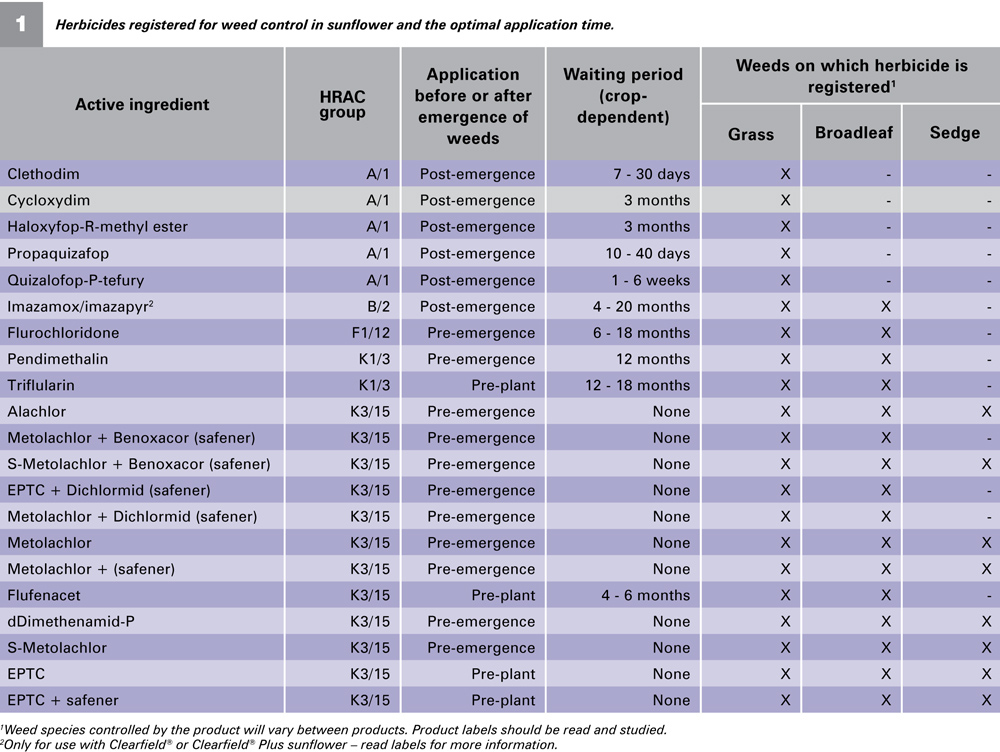October 2023
| PIETMAN BOTHA, INDEPENDENT AGRICULTURAL CONSULTANT AND DR MARYKE CRAVEN, SENIOR RESEARCHER, ARC-SMALL GRAIN |
 |
Weed control in sunflower must be done effectively and with precise timing because young sunflowers are very sensitive to weed competition. To keep sunflower fields clean, an integrated weed control programme needs to be implemented. This means a total all-inclusive herbicide control plan, where the effect of various agronomic, mechanical and chemical components is included to control weed.
Farmers should focus on weed control, especially from germination up to the V8 stage (about six weeks after planting). In the following stages of the plant, the effect of weeds is not such a big problem because leaves and the leave canopy effect should be sufficiently shaped to suppress the weeds naturally.
However, unlike with crops such as corn and soybeans, the options are limited for herbicides that can control post-emergence broadleaf weeds in sunflower. Weed control, especially broadleaf weeds in non-Clearfield sunflower, remains difficult and needs proper planning before the crop is planted.
In the planning for sunflower weed control, farmers should start with the selection of the fields where sunflower can be planted. Begin with the implementation of a crop rotation system, where crops like maize are planted a year before the sunflowers are planted.
Make sure that this maize is managed in such a way that the broadleaf weeds are properly controlled and that the crop rotation with sunflower is kept in mind with the selection of herbicides. If crop rotation is not applied, firstly choose fields where broadleaf weeds are not such a big problem and plant them with sunflowers.
BROADLEAF AND GRASS CONTROL
Before planting, get yourself a very good broadleaf and grass control plan where pre- and post-emergence herbicides are used to control the weeds. In the case where the weed pressure is very high, the use of implements is needed. The rolling of sunflower seeds before germination helps a lot to control weeds in the rows.
If non-Clearfield sunflowers or Clearfield sunflowers are planted, a weed cultivator that works shallow between the rows can be used to control the weeds before the Clearfield herbicide is applied.
Grass control in sunflower must preferably be done before germination. This can be done before planting or by spraying of the sunflowers before it germinates. Read the different herbicide labels for the best advice and to calculate the different application rates.
The Clearfield® and Clearfield® Plus cultivars provide the farmer with the option to control broadleaf weeds post-emergence in sunflower. Product labels should be read and studied to understand when and how much herbicide to apply to manage the weeds. Just make sure that there is sufficient time available before the follow-up crop is planted.
Some pre-plant and pre-emergence herbicides mainly control grass weeds, but some of these herbicides can also control certain broadleaf weeds – although this is sometimes variable with some of the weed species. These types of herbicides require that they must be worked into the soil (as with pre-plant herbicides) or that between 10 mm and 15 mm of rain must fall within seven days of application so that the herbicide can be washed into the soil. Remember to incorporate these requirements into the selection of herbicides.
In contrast, post-emergence herbicides are applied after the weed has already germinated. Active ingredients registered for post-emergence control of broadleaf weeds are currently limited to Imazamox/Imazapyr. However, these types of herbicides can only be applied to Clearfield® and Clearfield® Plus sunflower varieties. Don’t try it on other cultivars as it will kill the sunflowers, as some farmers have already experienced.
To prevent herbicide resistance populations from arising on your farm, herbicides with different mechanisms of action (or HRAC groups) must be varied in production systems. The implementation of a crop rotation system where sunflower is rotated with example maize will also help to prevent herbicide resistance.
The active ingredients that are currently registered for weed control in sunflower, as well as the type of weeds (broadleaf, grass or sedges) that they can control, are shown in Table 1. However, it is important to take note of any waiting periods that may be linked to a specific product because this can affect crop rotation systems.

Publication: October 2023
Section: Pula/Imvula